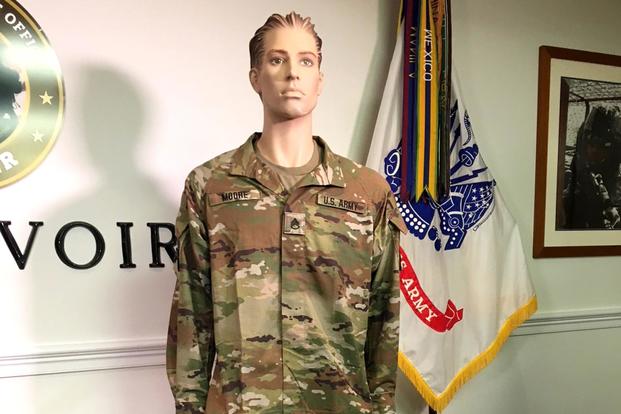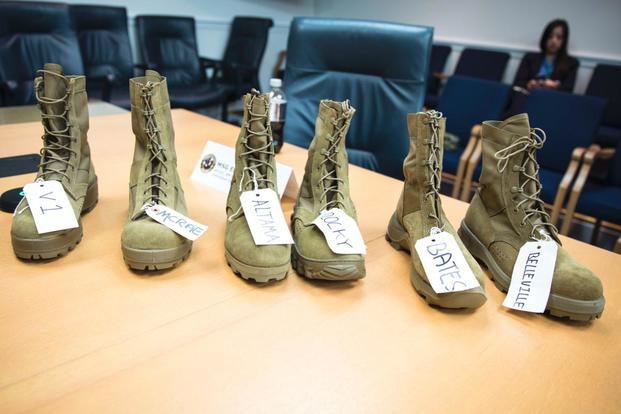U.S. Army uniform officials will soon begin testing a new hot weather combat uniform that's designed to dry more than 30 percent faster than the current Army Combat Uniform.
The Improved Hot Weather Combat Uniform, which features a lighter, more-breathable fabric than the current 50-50 Nylon-cotton blend, will be fielded to soldiers in the 25th Infantry Division in Hawaii for testing in January, Capt. Daniel Ferenczy, assistant product manager for Environmental Clothing and Footwear at Soldier Clothing and Individual Equipment, told reporters Thursday.
The new uniform's fabric is 57 percent Nylon and 43 percent cotton, which dries about 30 minutes faster than the ACU's 90-minute dry time under lab conditions, uniform officials maintain.
The fabric is also more breathable.
Related content:
- Sound Off: Did Army's Uniforms Provide an Unfair Camo Advantage?
- Army to Test New Jungle Boot Designs
- Army Testing Improved Hot Weather Combat Uniform
"Lab tests have shown the air permeability on this new 57-43 NYCO is about 70 cubic feet per meter as opposed to the ACU which is about 30 cubic feet per meter," Ferenczy said.
In addition to testing the new hot-weather uniform, uniform officials also plan to test five new designs of a lighter jungle boot, known as the Jungle Combat Boot Version 2, in January.
"Today's soldiers must be ready to execute their mission in any operational environment," Col. Stephen Thomas, who runs Project Manager for Soldier Protection and Individual Equipment, said.
"The improved Hot Weather Combat Uniform and the Jungle Combat Boot are aligned with Army modernization in terms of providing the capability to the warfighter to allow them to operate in a hot, wet environments."
In addition to its lighter fabric, the improved hot weather uniform features several design changes intended to keep soldiers cooler and more comfortable in hot humid conditions, Ferenczy said.
There is no mandarin collar and no breast pockets on the blouse. There are button closures on the shoulder pockets.
"The design behind it was intended to reduce layers and seams; layers and seams in fabric hold moisture, they hold heat," Ferenczy said.
The trousers have no back pockets and feature a gusseted crotch to prevent blowouts and improve comfort. Articulated knees "give a little bit more room for your knee to maneuver in that space," Ferenczy said.
The trousers also feature a mesh ankle wrap, since soldiers in the jungle are often wearing trousers that are not bloused, Ferenczy said.
"Soldiers in the jungle tend to have problems with bugs, leeches, mosquitos, so there is this mesh on the ankle. You tuck it in your boot," Ferenczy said, explaining that the design helps water drain out and prevent bugs from crawling up the trouser leg. "Soldiers have said 'it is really awesome.'"
The plan is to issue 65,000 pairs of the new uniforms -- four sets to each soldier -- in January
"They will wear them throughout the Pacific in various environments," Ferenczy said, adding that uniform officials will return in March to collect feedback.
The Army also plans to evaluate up to five additional fabric types in 2018 in Pacific Pathways wear test next summer, Uniform officials maintain.
The Army will also test five versions of the Jungle Combat Boot Version 2 in January.
The Army fielded 9,000 pairs of its newly-designed Jungle Combat Boots between March and August to the 25th Infantry Division's 2nd and 3rd Brigade Combat teams.
Soldiers liked the boots but wanted them lighter, more flexible and lower profile, Ferenczy said.
In April, the Army issued a request for information to boot manufacturers, for new jungle boot designs. The Army then issued contracts to Altama, Bates, Bellville, Mcrae, and Rocky boot makers to submit their prototype boots for testing.
The improved designs are not radically different from the first version of the Jungle Combat Boot, Ferenczi said.
The plan is to issue 150 pairs of each design one battalion from the 25th ID and return in March to collect feedback, Ferenczi said.
The Army and the Marine Corps retired the popular, Vietnam War-era jungle boots in the mid-2000s when both services transitioned to a desert-style combat boot for combat operations in Iraq and Afghanistan.
-- Matthew Cox can be reached at matthew.cox@military.com.











